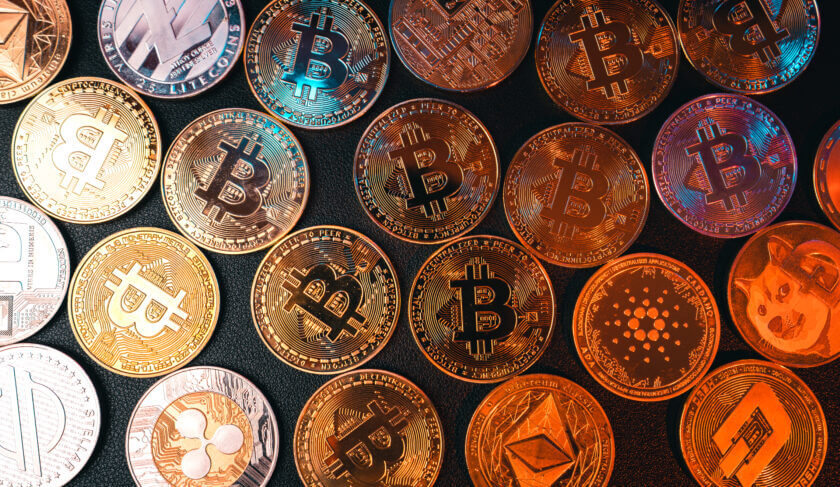
Today the crypto industry feels a lot like Artificial Intelligence (AI) — things are rapidly evolving, and there are just as many question marks surrounding things as there are exclamation points. What does it mean to invest in crypto in 2023? Is crypto safe? Should crypto be part of our retirement accounts? Here’s a look at where we stand heading into the third quarter of 2023.
What is cryptocurrency?
Cryptocurrency is a digital currency that’s verified through blockchain technology, which creates an incorruptible digital ledger of transactions that are based on mathematical formulas. (To learn more, check out our special “Crypto 101″ podcast where we explained everything there is to know about crypto!)
But let’s make that even simpler: Cryptocurrency is a digital currency for a digital world — the kind in which hovering your phone over a terminal will let you pay for a latte. Sound familiar? With cryptocurrency, there are no bills, coins, checks or plastic cards. Crypto is a “decentralized” currency, which means there’s no governing body, and no centralized bank, like the Federal Reserve, determining policy for the currency… for now. (The current furor is due to the fact that the SEC just made inroads to regulating crypto trading platforms like Coinbase, so big changes could be on the horizon in the years to come. More on that below.)
JOIN US! Our best money and life advice delivered to your email box for free each week. Subscribe to HerMoney today.
What makes cryptocurrency difficult for people to understand is that it isn’t anything you can touch — all you possess to show ownership is what’s on your blockchain ledger that you can transfer to someone else. And with historically volatile values, it still seems a little like a digital wild west out there.
Bitcoin was the first cryptocurrency that came onto the scene in 2009 and it still remains the most widely traded and best known — its name is often used to symbolize all forms of crypto the way “Coke,” is shorthand for all types of soda in the South. Bitcoin is a publicly traded company, under the symbol BTC. But today there are thousands of forms of cryptocurrency (the second best-known being Ethereum) and they all have varying degrees of liquidity and security backing them up.
For the more complicated questions regarding crypto, we spoke with one of the handful of people who truly understands it, Nitin Gaur, Global Head of Digital Assets and Technology at State Street Digital, and the former director of IBM’s Blockchain Labs. (IBM was an early investor in blockchain technology and continues to expand its reach and expertise. Blockchain has far-reaching applications not just for crypto, but for all forms of digital security, in the financial and health sectors, and many more.)
Is cryptocurrency real currency?
Yes…and no. Can you spend it at the grocery store? Not yet, but maybe down the road. But some people and companies pay bills with Bitcoin and some places accept it for payment, understanding that there will likely be a fluctuation – up or down – in the amount received. Then the exchange takes a commission if the crypto is converted into dollars.
Gaur views crypto as the “fifth asset class,” alongside cash, equities, bonds and private markets. “Crypto opens up a new class that has its own economic system, and its own advantages and potential growth perspectives,” he says. “But like any new industry, it’s also laden with confusion and fraudulent behaviors.”
LISTEN: Your Crypto Questions, Answered
For the average investor, Gaur says the goal is to try to understand the foundational elements that drive crypto’s shift from a speculative asset to a utility asset, because every asset that we deal with has utility. “We make use of those assets for productive economies,” he explains.
With that said, if crypto isn’t your fifth asset class just yet, don’t feel bad. For many years, the crypto experts HerMoney’s editors have spoken with recommend investing no more than 1% to 2% of your total investing budget in crypto, due to its volatility. Not everyone has the stomach to watch Bitcoin’s wild swings — especially not if it’s money we’re depending on for retirement. Which brings us to our next point…
Should crypto be part of your retirement account?
“I always view new asset classes as diversification avenues,” Gaur says. “Investors should try with at least putting in a minuscule amount that they’re willing to lose, just like any investment, to learn the industry. View it as tuition to learn a new industry, and to learn the behavior of these asset classes.” In other words, it’s nice to have a little skin in the game, and maybe even roll out with a little crypto lingo at your next cocktail party — but just because crypto is a growing sector in our economy doesn’t mean it has to be a growing division of your personal portfolio, unless you want it to be.
READ MORE: Everything You Wanted To Know About Making Money With Bitcoin, Blockchain and Cryptocurrency
What the Internet did for the dissemination of information, Gaur says, Blockchain technology will do for cryptocurrencies – make them ubiquitous and global and level the playing field for smaller investors, allowing for the fractional purchases of assets. And, just as with the early days of the Internet, it will take years for the dust to settle — and the early winners (hi, AOL) may not prove to be victorious in the end.
So, how do you buy/sell crypto?
Basically, you have two options, Gaur says. Either you buy the asset through an exchange (like Coinbase) or you can buy a crypto-based ETF (via your trading platform of choice), of which there are many. For example, HerMoney’s InvestingFixx portfolio has the XLE ETF comprised of energy companies, but there are also ETFs focused on crypto assets. For a different level of risk, there are crypto futures. These are contracts which allow you to speculate on the future price of crypto assets without actually purchasing the assets – similar to options trading of stocks.
In terms of the “safest” ways to invest in crypto Gaur believes that the regulated exchanges such as Coinbase are “quite a safe way to get into it because they have the risk control procedures in place. Coinbase (COIN) is a public company and they have reporting requirements, and they have invested in technologies for safekeeping and safeguarding the assets, which can be a challenge for many of these companies and entities.”
What about getting exposure to crypto without actually buying crypto assets?
Gaur mentions MicroStrategy (MSTR), a business technology intelligence company that also has a lot of Bitcoin investment on its balance sheet, as a way to gain from the rise of Bitcoin, without actually owning any Bitcoin. He also points to digital mining companies like Marathon Digital (MARA) and Riot (with the apt symbol RIOT). “They are the production houses of Bitcoin,” he says, “providing the computer infrastructure. There are a number of these companies.”
Others that should increase in value if crypto becomes more common are chip companies like Nvidia (NVDA) which makes the chips used by mining companies. “As the crypto industry grows, all these adjacent industries should grow because they’re providing core services to the crypto industry,” Gaur says.
What about Coinbase’s troubles with the SEC?
As we mentioned above, the SEC has sued crypto trading platforms Coinbase and Binance for allegedly operating unregulated exchanges – as opposed to the New York Stock Exchange and NASDAQ which are regulated – allowing for the trading of crypto with minimal oversight, which was originally the point of crypto. (Essentially, the SEC is arguing that crypto tokens are actually just unregistered securities, which means that Coinbase and Binance are technically illegal exchanges. Coinbase stock (COIN) has fallen about 15% on that news and Bitcoin itself is down about 9% in the last month.)
Gaur believes crypto exchanges are necessary. “Exchanges such as Coinbase and Binance provide an important function of bringing liquidity from traditional finance, into crypto finance,” he says, “and allow for common investors to be able to access a digital asset or crypto assets without engaging in the crypto economic systems like mining and minting, which are technically complicated also require a substantial level of investment.”
The problem the SEC is trying to address, though, is that with so many cryptocurrencies on the market today, not all of them have the clarity and transparency needed to keep investors safe.
READ MORE:
- 10 Investing Questions Answered in Plain English
- This May Be the Only Mutual Fund You Need To Own
- 5 Ways to Buy Stocks for Kids
JOIN US!: Our best money and life advice delivered to your email box for free each week. Subscribe to HerMoney today.







